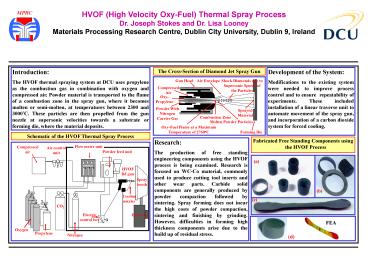HVOF (High Velocity Oxy-Fuel) Thermal Spray Process Dr. Joseph Stokes and Dr. Lisa Looney Materials Processing Research Centre, Dublin City University, Dublin 9, Ireland - PowerPoint PPT Presentation
1 / 1
Title:
HVOF (High Velocity Oxy-Fuel) Thermal Spray Process Dr. Joseph Stokes and Dr. Lisa Looney Materials Processing Research Centre, Dublin City University, Dublin 9, Ireland
Description:
HVOF (High Velocity Oxy-Fuel) Thermal Spray Process Dr. Joseph Stokes and Dr. Lisa Looney Materials Processing Research Centre, Dublin City University, Dublin 9, Ireland – PowerPoint PPT presentation
Number of Views:894
Avg rating:3.0/5.0
Title: HVOF (High Velocity Oxy-Fuel) Thermal Spray Process Dr. Joseph Stokes and Dr. Lisa Looney Materials Processing Research Centre, Dublin City University, Dublin 9, Ireland
1
HVOF (High Velocity Oxy-Fuel) Thermal Spray
Process Dr. Joseph Stokes and Dr. Lisa
LooneyMaterials Processing Research Centre,
Dublin City University, Dublin 9, Ireland
Development of the System Modifications to the
existing system were needed to improve process
control and to ensure repeatability of
experiments. These included installation of a
linear traverse unit to automate movement of the
spray gun, and incorporation of a carbon dioxide
system for forced cooling.
Introduction The HVOF thermal spraying system at
DCU uses propylene as the combustion gas in
combination with oxygen and compressed air.
Powder material is transported to the flame of a
combustion zone in the spray gun, where it
becomes molten or semi-molten, at temperatures
between 2300 and 3000C. These particles are then
propelled from the gun nozzle at supersonic
velocities towards a substrate or forming die,
where the material deposits.
The Cross-Section of Diamond Jet Spray Gun
Schematic of the HVOF Thermal Spray Process
Fabricated Free Standing Components using the
HVOF Process
Research The production of free standing
engineering components using the HVOF process is
being examined. Research is focused on WC-Co
material, commonly used to produce cutting tool
inserts and other wear parts. Carbide solid
components are generally produced by powder
compaction followed by sintering. Spray forming
does not incur the high costs of powder
compaction, sintering and finishing by grinding.
However, difficulties in forming high thickness
components arise due to the build up of residual
stress.
(a)
(b)
(c)
FEA
(d)































